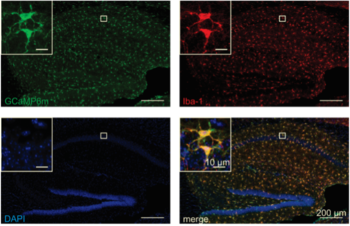Prof. Dr. Marcus Semtner

Institute of Biology / Max Delbrück Center
Visiting Professor
14195 Berlin
Neuroimmunology and physiology of microglia
Microglia are the resident immune cells of the brain. Their physiological role is to protect the brain from infection and damage, to promote tissue repair and regeneration, and to nurture neurons and other glial cells by secretion of growth factors, cytokines and other signal molecules. Microglia are also involved in the removal of synapses in the framework of neuronal plasticity in the healthy brain. Some of the microglial processes rest for several minutes and make direct contact with neuronal synapses at a frequency of about one per hour. Neuronal activity regulates the microglial engulfment of synaptic structures, whereas microglial cells preferentially remove less active inputs. Our major research interest is to understand how microglia can recognize synaptic activity and how these signals are transduced intracellularly to change microglial morphology and behaviour. The primary focus is on signalling through G protein-coupled receptors including those which are linked to calcium ions and those which are linked to cAMP as second messenger. Many of the substances that can influence microglial behaviour act on microglial G protein-coupled receptors (e.g. chemokine, complement, hormone, neurotransmitter or purinergic receptors). Thus, the identification of commonalities and differences in microglial G protein signaling will facilitate the future option to estimate the effect of therapeutical drug treatments on immune responses in the brain.
In a recent publication, we describe a novel mouse model in which microglia, but no other brain cells, express the Ca2+ reporter GCaMP6m and the fluorescence reporter mCherry. Using this mouse model, we are able to decipher neuron- and astrocyte- to-microglia communication in acute living brain slices and in vivo.
Publications (recent 5 years)
Bakina, O., T. Conrad, N. Mitic, R. O. Vidal, T. Obrusnik, S. Sai, C. Nolte, M. Semtner & H. Kettenmann (2024). "In situ Patch-seq analysis of microglia reveals a lack of stress genes as found in FACS-isolated microglia." PLoS One 19(7): e0302376.
Kompier, N., M. Semtner, S. Walter, N. Kakabadze, C. Steinhäuser, C. Nolte and H. Kettenmann (2024). "Membrane properties and coupling of macroglia in the optic nerve." Curr Res Neurobiol 7: 100137.
Logiacco, F., L. C. Grzegorzek, E. C. Cordell, O. Popp, P. Mertins, D. H. Gutmann, H. Kettenmann & M. Semtner (2023). "Neurofibromatosis type 1-dependent alterations in mouse microglia function are not cell-intrinsic." Acta Neuropathol Commun 11(1): 36. (IF: 6.2)
Guneykaya, D., B. Ugursu, F. Logiacco, O. Popp, M. A. Feiks, N. Meyer, S. Wendt, M. Semtner, F. Cherif, C. Gauthier, C. Madore, Z. Yin, Ö. Çınar, T. Arslan, Z. Gerevich, P. Mertins, O. Butovsky, H. Kettenmann and S. A. Wolf (2023). "Sex-specific microglia state in the Neuroligin-4 knock-out mouse model of autism spectrum disorder." Brain Behav Immun 111: 61-75.
Fricke, S., M. Harnau, F. Hetsch, H. Liu, J. Leonhard, A. Eylmann, P. Knauff, H. Sun, M. Semtner and J. C. Meier (2023). "Cesium activates the neurotransmitter receptor for glycine." Front Mol Neurosci 16: 1018530.
F. Logiacco, P. Xia, S.V. Georgiev, C. Franconi, Y.J. Chang, B. Ugursu, A. Sporbert, R. Kühn, H. Kettenmann*, & M. Semtner* (2021) Microglia sense neuronal activity via GABA in the early postnatal hippocampus. Cell Rep 37,110128
P. Xia, F. Logiacco, Y. Huang, H. Kettenmann* & M. Semtner*. (2021) Histamine triggers microglial responses indirectly via astrocytes and purinergic signaling. Glia 69, 2291-2304
N. Elmadany, F. Logiacco, A. Buonfiglioli, V. C. Haage, E. C. Wright-Jin, A. Schattenberg, R. M. Papawassiliou, H. Kettenmann, M. Semtner* & D. H. Gutmann*. (2020) Neurofibromatosis 1 - Mutant microglia exhibit sexually-dimorphic cyclic AMP-dependent purinergic defects. Neurobiol Dis 144, 105030
N. Elmadany, F. de Almeida Sassi, S. Wendt, F. Logiacco, J. Visser, V. Haage, D. P. Hernandez, P. Mertins, D. Hambardzumyan, S. Wolf, H. Kettenmann* & M. Semtner*. (2020) The VGF-derived Peptide TLQP21 Impairs Purinergic Control of Chemotaxis and Phagocytosis in Mouse Microglia. J Neurosci 40, 3320-3331
F. Hu, Y. Huang, M. Semtner, K. Zhao, Z. Tan, O. Dzaye, H. Kettenmann, K. Shu and T. Lei. (2020) Down-regulation of Aquaporin-1 mediates a microglial phenotype switch affecting glioma growth. Exp Cell Res 396, 112323
V. Haage*& M. Semtner*& R. O. Vidal*, D. P. Hernandez, W. W. Pong, Z. Chen, D. Hambardzumyan, V. Magrini, A. Ly, J. Walker, E. Mardis, P. Mertins, S. Sauer, H. Kettenmann and D. H. Gutmann. (2019b) Comprehensive gene expression meta-analysis identifies signature genes that distinguish microglia from peripheral monocytes/macrophages in health and glioma. Acta Neuropathol Commun 7, 20 (IF: 6.27)
A. Buonfiglioli, I. E. Efe, D. Guneykaya, A. Ivanov, Y. Huang, E. Orlowski, C. Kruger, R. A. Deisz, D. Markovic, C. Fluh, A. G. Newman, U. C. Schneider, D. Beule, S. A. Wolf, O. Dzaye, D. H. Gutmann, M. Semtner, H. Kettenmann and S. Lehnardt. (2019a) let-7 MicroRNAs Regulate Microglial Function and Suppress Glioma Growth through Toll-Like Receptor 7. Cell Rep 29, 3460-3471.e7
V. Haage, N. Elmadany, L. Roll, A. Faissner, D. H. Gutmann, M. Semtner* & H. Kettenmann*. (2019) Tenascin C regulates multiple microglial functions involving TLR4 signaling and HDAC1. Brain Behav Immun 81, 470-483 (IF: 7.217)
